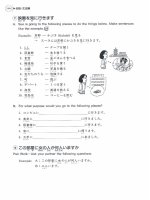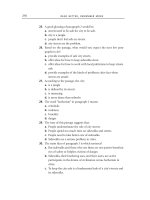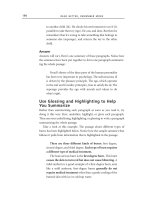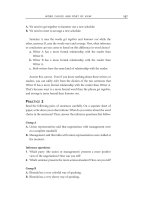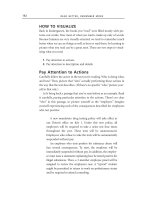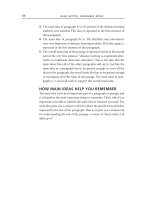READ BETTER REMEMBER MORE 2e phần 6 docx
Bạn đang xem bản rút gọn của tài liệu. Xem và tải ngay bản đầy đủ của tài liệu tại đây (137.37 KB, 28 trang )
READ BETTER, REMEMBER MORE
114
CAUSE AND EFFECT
When ideas are organized by cause and effect, they’re arranged in one of
the following two ways:
1. What happened (the cause) and what happened as a result (the
effect)
2. What happened or will happen (the effect) and why it happened or
will happen (the cause)
Certain types of sentences should lead you to expect a cause and effect
organizational pattern. Here are some examples:
• There were many factors that led up to the Vietnam war. (You
should expect causes to follow.)
• Turning farmland into housing developments will have a negative
impact on our county’s economy and ecology. (You should expect
effects to follow.)
• When he decided to quit school, he had no idea how that decision
would change his life. (You should expect effects to follow.)
The following transitional words and phrases help signal the cause
and effect organizational pattern:
therefore thus
because consequently
as a result accordingly
so hence
since then
P
RACTICE
4
Write a brief paragraph using the cause and effect organizational pattern.
Answer
Answers will vary. Here’s one possibility:
The changes in the tuition reimbursement policy will have
several negative effects. Employees will be less loyal to the
RECOGNIZING ORGANIZATIONAL STRATEGIES
115
company. They will also be less likely to seek opportunities to
increase their knowledge. In addition, they will be less likely
to advance within the company, so management positions
will have to be filled from outside rather than inside when
there are vacancies.
SPATIAL
In some texts, ideas are organized according to spatial principles: from
top to bottom, side to side, inside to outside, and so on. Transitional
words showing that a text is spatially organized include:
beside beyond
next to behind
around in front of
above under
below near
PRACTICE 5
Read the following paragraph carefully. What is the specific spatial prin-
ciple the writer has used to organize her ideas? What transitional words
help you follow her organization?
The human body is covered by a “suit of armor”—the skin. The
skin offers three layers of protection. The outer most layer is called
the keratin. This is what we see when we look at skin. Beneath the
keratin is the epidermis. Nerve cells are located in the next level,
the dermis. And underneath these three layers is the subcutaneous
tissue, which contains the sweat glands.
Answer
The paragraph is organized from outside to inside, or top to bottom. The
transitional phrases are beneath, in the next level, and underneath.
ANALYSIS/CLASSIFICATION
In texts arranged by analysis or classification, ideas are organized according
to the parts, functions, or types of something. The text you read about the
different kinds of burns was one example of this structure. Here’s another:
READ BETTER, REMEMBER MORE
116
The model 6017A fax machine has several important functions.
First, it is, of course, capable of sending and receiving faxes.
Second, it can print documents directly from your PC. Third, it
can copy documents.
Sometimes analysis/classification calls for transitional words you’ve
seen before, like first, second, third. The biggest clue to the analysis or clas-
sification type of organization is any sentence with the following pattern:
• “X has several parts.”
• “There are three types of X.”
• “X has several different functions.”
• “X is made of four different components.”
P
RACTICE 6
In the following paragraph, underline the sentence that leads you to
expect an analysis/classification pattern of organization, and then circle
words or phrases that signal the classes or parts that the writer divides his
subject into.
There are three types of readers. The unskilled reader is easily
distracted and thinks of reading as a passive task. This reader doesn’t
make any effort to understand or remember what she reads. The
skill-building reader knows that reading is an active task but is still
learning how to make the most of active reading strategies. Finally,
the skilled reader reads actively and responds to what she reads.
Answer
There are three types of readers. The unskilled reader is easily
distracted and thinks of reading as a passive task. This reader doesn’t
make any effort to understand or remember what she reads. The
skill-building reader knows that reading is an active task but is still
learning how to make the most of active reading strategies. Finally,
the skilled reader reads actively and responds to what she reads.
RECOGNIZING ORGANIZATIONAL STRATEGIES
117
ORDER OF IMPORTANCE
With this pattern, ideas are presented in order of most important to least
important or vice versa—from least important to most important.
Several key transitional words and phrases often guide readers through
this kind of organization:
more importantly furthermore first, second, third
moreover above all first and foremost
in addition certainlyl ast but not least
The passage about burns in Chapter 8 is not only organized by classi-
fication/analysis; it’s also organized by order of importance. It starts by
describing the least serious burn (1st degree) and ends with the most
serious burn (3rd degree). Here are examples of the type of sentences
that set up this kind of organization:
• There are three reasons you shouldn’t vote for Ms. Roberts. First of
all
• Studies show there are important health benefits of eating fresh
broccoli. One benefit is
PRACTICE 7
Read the following paragraph carefully. Is it organized from most to least
important or least to most important? How can you tell?
It is essential that young adults begin to build a solid credit rating
as soon as they are of age. First of all, a good credit rating makes it
much easier to acquire credit cards, which are important for
further building your credit. Second, a good credit rating is essen-
tial for getting a loan or mortgage. Third, if you are ever in a seri-
ous emergency, your good credit rating will make it possible for
you to get the money, credit, or assistance you need because you’ve
proven that you’re trustworthy.
Answer
This paragraph is organized from least to most important. Because the
third reason deals with emergencies, it is the most important.
READ BETTER, REMEMBER MORE
118
COMPARISON AND CONTRAST
When writers want to show how two or more things are similar and/or
different, they arrange their ideas in a comparison and contrast format.
Comparisons show similarities while contrasts show differences.
There are two ways writers organize comparison and contrast texts.
For example, let’s say a writer wants to compare his previous job (Job A)
with his current job (Job B). There are three different characteristics of A
and B that he wants to compare: (1) the compensation, (2) the job duties,
and (3) the job environment.
If this writer were to use the block technique, he would deal with each
job individually. That is, he would discuss each of these three character-
istics for Job A and then each characteristic for Job B. The structure of
such a passage would look like this:
First paragraph Second paragraph
Job A1—compensation JobB1—compensation
Job A2—duties Job B2—duties
Job A3—environment Job B3—environment
If this writer were to use the point-by-point technique, on the other
hand, he would be making a more direct comparison. In a point-by-
point comparison and contrast, writers organize ideas by characteristic
rather than by item. Thus, the writer would compare compensation for
both jobs first, then duties at both jobs, then finally the environment in
both companies.
First paragraph Second paragraph Third paragraph
Job A1—compensation Job A2—duties Job A3—environment
JobB1—compensation Job B2—duties Job B3—environment
A number of transitions signal the comparison and contrast organi-
zational structure:
Words to signal comparison:
likewise like also
similarly in the same way
RECOGNIZING ORGANIZATIONAL STRATEGIES
119
Words to signal contrast:
on the other hand yet although
however nevertheless nonetheless
on the contrary rather despite
unlike instead in contrast
but whereas conversely
PRACTICE
8
Here’s an example of a comparison and contrast paragraph. Which orga-
nizational method does it use?
Darwinism vs. Creationism. Both Darwinism and Creation-
ism are theories that explain the origin of life on earth.
Creationists believe that humans and all living beings on the
Earth were created by God. Darwinists, on the other hand,
maintain that living creatures came about as a result of
evolution—that is, today’s life forms evolved from earlier,
simpler life forms. Creationism is a theory based in religion,
whereas Darwinism has its roots in scientific investigation.
Answer
This paragraph uses the point-by-point technique.
Multiple Strategies
It’s important to remember that many texts use two or more organiza-
tional strategies at the same time. For example, the paragraph below uses
both the cause and effect and order of importance patterns:
Too much sun can be deadly. First of all, too much sun can
dry your skin, which in turn reduces its elasticity and speeds
the aging process. Second, too much sun can burn unpro-
tected skin and cause permanent discoloration and damage
the dermis. Most importantly, long-term exposure of unpro-
tected skin can result in skin cancer.
Meanwhile, this individual paragraph, which combines two different
organizational strategies, may be part of a larger text that is organized by
READ BETTER, REMEMBER MORE
120
a different strategy, such as analysis/classification. And the various para-
graphs within that text may use different strategies and combinations of
strategies. The point is that both on the “big picture” level (the entire
text) and on the level of individual paragraphs, organizational patterns
are at work. If you can recognize them, you can anticipate what’s ahead,
and this makes it easier to receive that information. In addition, it’s much
easier to remember things that are in patterns. The more you recognize
patterns in what you read, the easier it will be to remember that infor-
mation.
P
RACTICE 9
Read each sentence below carefully. Based on the sentence, what kind of
information do you expect to follow? What organizational pattern will
the writer use?
1. The shape and size of a widget depends upon what it will be used for.
2. A hesitating engine may be the sign of several different problems.
3. A union meeting was held on Thursday, May 8, at 8 a.m.
4. Euthanasia is a highly controversial issue.
5. There are many differences between ice cream and frozen yogurt.
Answers
1. I expect to learn what kinds of things widgets are used for. Analysis/
classification pattern.
2. I expect to learn what might cause an engine to hesitate. Cause and
effect pattern.
3. I expect to learn what happened at the meeting. Chronological/
sequential pattern.
4. I expect to know exactly why euthanasia is a controversial issue.
General to specific pattern.
5. I expect to learn about the differences between ice cream and frozen
yogurt. Compare and contrast pattern.
RECOGNIZING ORGANIZATIONAL STRATEGIES
121
IN SHORT
Writers use different patterns to organize their ideas. These organiza-
tional patterns include:
• General to Specific
• Specific to General
• Chronological/Sequential
• Cause and Effect
• Spatial
• Analysis/Classification
• Order of Importance
• Comparison and Contrast
Writers often use certain transitional words and phrases to signal their
organizational pattern. By recognizing a writer’s organizational pattern,
you can anticipate what’s ahead and better remember what you read.
Skill Building Until Next Time
1. Try to determine the organizational pattern of the things you read
today and throughout the week. Remember that writers can use
more than one strategy at a time.
2. Practice asking “anticipation” questions. Whenever you come
across signal words or sentences that suggest a certain structure,
ask questions about what’s next.
CHAPTER
12
D
ISTINGUISHING
F
ACT FROM
O
PINION
One of the most
important signs of a
good reader is the ability
to distinguish between
fact and opinion. This
chapter will show you
how facts are different
from opinions and how
this distinction can help
you remember more.
“J
ust the facts, ma’am, just the facts.”
This often-quoted line comes from the 1960s televi-
sion series “Dragnet.” On the show, Detective Joe
Friday and his partner would solve crimes by piecing together the facts
of each case. When Detective Friday told a witness that he was looking
for “just the facts,” he was making an important distinction between
fact and opinion. It didn’t matter to him who witnesses thought did it
or what witnesses thought happened. Rather, he needed to know what
really happened.
The key difference between fact and opinion lies in the difference
between believing and knowing. Opinions may be based on facts, but
READ BETTER, REMEMBER MORE
124
they are still what people think or believe, not what
they know. Opinions are debatable; facts are not. For
example, “Basketball is the most exciting sport” is
debatable; you might disagree. Thus, it’s an opinion.
But “Basketball is a team sport” is not debatable; it’s
impossible to disagree with this statement. It’s a fact;
it’s known for certain to be true.
You will understand and remember more if you
can distinguish between fact and opinion—between
what the writer thinks and what the writer knows,
between what is proven to be true and what needs to be proven. This is
largely because you can react to an idea once you identify it as either a fact
or an opinion. You’ll learn more about this in Chapter 13.
ASKING QUESTIONS
A good test for whether something is a fact or opinion is to ask yourself,
“Can this statement be debated? Is this known for certain to be true?” If
you can answer yes to the first question, you probably
have an opinion. If you can answer yes to the second,
you probably have a fact. For example, think back to
the topic sentences you created in Chapter 6. Were they
assertions that expressed fact, or opinion? Here’s one
topic sentence from that chapter:
The number of work-related accidents has dropped
by 50 percent.
Does this topic sentence express a fact or an opinion?
Well, is it debatable? Can someone disagree? Probably
not. It’s a matter of fact; something proven to be true by the specific
statistics provided in the rest of the paragraph.
Now look at this topic sentence:
Vanessa is a wonderful supervisor.
What are Facts?
• Facts are things known
for certain to have
happened.
• Facts are things known
for certain to be true.
• Facts are things known
for certain to exist.
What are Opinions?
• Opinions are things
believed or thought
to have happened.
• Opinions are things
believed or thought
to be true.
• Opinions are things
believed or thought
to exist.
DISTINGUISHING FACT FROM OPINION
125
Is this idea debatable? Definitely. Someone else might think she’s a lousy
supervisor, and someone else might think she’s just okay. This sentence is
clearly a matter of opinion.
PRACTICE
1
Determine whether the following sentences are fact or opinion:
1. America is a democratic country.
2. America must preserve democracy at all costs.
3. The meetings should be held on Tuesdays, not Wednesdays.
4. These meetings are held Wednesdays.
5. These meetings are often a waste of time.
Answers
1.Fact
2. Opinion
3. Opinion
4.Fact
5. Opinion
WHEN FACTS AND OPINIONS
ARE MIXED TOGETHER
It’s usually easy to determine whether something is fact or opinion when
it’s standing alone like the sentences you just reviewed. It’s a little more
complicated when you’re working with paragraphs and larger texts.
That’s because unless what you’re reading is a textbook or a scientific or
technical manual, you’ll probably come across a combination of facts and
opinions, sometimes even in the same sentence. Here’s an example:
Email and other technologies make it possible for many
people to work from home, and companies should fully
support employees who want to “telecommute.”
The first part of the sentence expresses a fact; technology has indeed
made telecommuting possible for a lot of employees. But the second part
of the sentence—that companies should support the folks who want to
work from home—is clearly debatable. It is an opinion.
READ BETTER, REMEMBER MORE
126
P
RACTICE 2
Here’s a paragraph that has both fact and opinion. See if you can
correctly identify which ideas are debatable and which are not. Underline
the facts and use a highlighter or colored pen to highlight the opinions.
(Some things may be neither; just leave those sections as is.)
New York and other U.S. cities have begun using vehicles
powered by natural gas. This is a good idea, because vehicles
that use natural gas do not pollute the air. Pollution is the
biggest problem facing cities right now. Furthermore,
natural gas is more cost-effective than regular gas. All cities
should use only vehicles powered by natural gas.
Answer
N
ew Y
ork and other U
.S. cities have begun using vehicles
p
owe
red by nat
ural gas
. This is a good idea, because v
ehicles
that use natural gas do not pollute the air. Pollution is the
biggest problem facing cities right now. Furthermore,
natural gas is more cost-effective than regular gas. All cities
should use only vehicles powered by natural gas.
SUPPORT FOR OPINIONS
Because facts are things that are known to be true, readers generally don’t
need evidence that they’re true. Readers do want details, explanations, or
examples, but they often don’t need you to prove your case.
Opinions, on the other hand, are debatable, and they always need
evidence. Readers need to see why writers think and say what they do.
Often this evidence will come in the form of facts. But just because a
writer offers evidence for an opinion doesn’t mean readers have to agree
with that opinion. The same facts can often be used to support many
different opinions.
Still, an opinion that is supported by evidence (examples, details,
reasons, explanations, or statistics) is much stronger than opinions that
stand alone. For example, read the two paragraphs below. In one, the
writer supports her opinion, but in the other she does not.
DISTINGUISHING FACT FROM OPINION
127
Edward Wilson was an outstanding employee and a great
supervisor. He was a nice guy, too.
Edward Wilson was an outstanding employee. He came to us
as an entry-level production worker and worked so well with
others that he became a team leader within a year. He was
such an excellent team leader that the following year he was
promoted to supervisor. While he was a supervisor, his crew
consistently met or exceeded production goals and had the
fewest problems of any team with quality control. In addi-
tion, Edward was a very kind and generous person. He often
went out of his way to help the people he supervised. He
covered their shifts in emergencies, gave them rides home
when they worked overtime, and helped them resolve
conflicts with others.
Why is the second paragraph so much better than the first? Because
the second paragraph offers you more than just opinions. It offers opin-
ions supported by specific facts and examples. The first paragraph, on the
other hand, is just opinions. Every sentence is debatable. Every sentence
says what the author thinks is true, but not what is known to be true.
The author of the first paragraph doesn’t provide any evidence to
support why she thinks Edward Wilson was a great employee. As a result,
we’re not likely to take her opinion very seriously—certainly not as seri-
ously as we take the opinion of the writer of the second paragraph.
PRACTICE 3
To strengthen your ability to distinguish between fact and opinion, try
this exercise. Take a fact, such as:
Many companies have dress down days on Fridays.
Then turn it into an opinion. Make a debatable statement about the
same subject, like the following:
1. Dress down days improve employee morale.
2. Every day should be a dress down day.
READ BETTER, REMEMBER MORE
128
3. Dress down days make workers less productive.
4. Dress down days make workers more productive.
Write three facts in the space below. Then, turn each fact into an opin-
ion. Make sure your facts are not debatable, and make sure your opinions
are. In fact, you may want to write two opposing opinions just to make
sure that your opinions are debatable (like 3 and 4 above).
1.
2.
3.
Answers
Answers will vary depending upon what facts you chose. Here are a few
examples of facts turned into opposing opinions:
Fact: Wednesdays are in the middle of the week.
Opinions: Wednesdays are always the longest day of the week.
Wednesdays are the most exciting day of the week.
Fact: Next Tuesday is election day.
Opinions: Everyone should vote in next Tuesday’s election.
No one should bother voting in next Tuesday’s election.
Fact: Reading to your children when they’re very young will help
them do better in school.
Opinions: All parents should read to their young children every day.
Parents should not read to their children.
HOW DISTINGUISHING BETWEEN FACT AND
OPINION CAN HELP YOU REMEMBER
Distinguishing between fact and opinion can help you remember more
of what you read because it helps you think critically about what you
read. When you’re distinguishing between fact and opinion, you’re essen-
tially asking yourself, “Is this something I should accept as true?” You can
DISTINGUISHING FACT FROM OPINION
129
also determine how you feel about an issue that the writer offers an opin-
ion about. You’ll see more about this in Chapter 13.
IN SHORT
Facts are things known for certain to be true. Opinions, on the other hand,
are things believed to be true. To distinguish between fact and opinion,
determine whether the idea is debatable or not. If it is debatable, it’s an
opinion. Good writers will support their opinions with evidence: details,
examples, facts, and so on.
Skill Building Until Next Time
1. Listen carefully to what other people around you say today. Are
they stating facts or expressing opinions? When they offer opin-
ions, do they provide support for them? Is it enough support for
you to find their opinion convincing?
2. Read the editorials in your newspaper this week. Notice how good
editorial writers use specific facts and examples to support their
opinions.
CHAPTER
13
R
ECORDING
Y
OUR
Q
UESTIONS AND
R
EACTIONS
One of the most effective
active reading strategies is
to “talk back” to the
writer. By recording your
questions and reactions in
the margin or on a piece
of paper, you can create a
dialogue that helps you
better remember
what you read.
W
hen you read, you usually don’t have the
opportunity to speak with the author, to ask questions
and make comments about the material. But that does-
n’t mean you can’t say what’s on your mind. In fact, if you do say what’s
on your mind, you’re much more likely to remember what you read.
That’s because you are both interacting with and reacting to the text,
responding to the ideas and information the author provides.
This kind of active reading takes several forms. Most reader reactions
fall into these main categories:
READ BETTER, REMEMBER MORE
132
• Asking questions
• Agreeing and disagreeing
• Making connections
• Evaluating
ASKING QUESTIONS
You’ve already studied how to ask questions to help you anticipate what’s
ahead. The kinds of questions discussed here are questions you ask in
response to the ideas you read. Is there anything you don’t understand?
Something you want to know more about? Below is an example of how
this kind of questioning works. Read the following paragraph carefully
and notice the questions in the margin:
No-Smoking Policy
Instituting a no-smoking policy in the office would create
more problems than it would solve. First of all, employees
who smoke would be forced to leave the building in order to
smoke. That means they would have to take longer breaks,
and, as a result, they’d spend less time working. They’d also
have to take fewer breaks so that their breaks can be longer.
That means there’ll be longer stretches of time between
cigarette breaks. Consequently, these employees will be
more irritable. Furthermore, we risk losing employees who
are long-term smokers. These employees may very well
quit to find another company that will let them smoke
while they work.
Asking questions like these shows you’re thinking critically about
what you read. In addition, because you’re formulating questions in
response to the ideas in the text, you’re more likely to remember those
ideas. And asking questions encourages you to find the answers to those
questions.
AGREEING AND DISAGREEING
You’re also much more likely to remember what you read if you know
how you feel about the ideas a writer conveys. When a writer offers an
opinion, you don’t have to simply accept or reject it. You can—and
How many smokers
are there? ratio
of smokers vs.
non-smokers?
What prob-
lems would
it solve?
Could they
make a
smoking
lounge?
Could company
sponsor programs
to help smokers
quit?
RECORDING YOUR QUESTIONS AND REACTIONS
133
should—react to it. Do you agree or disagree with it? Do you think what
the writer said is brilliant, or malarkey? Why?
Here’s the no-smoking policy paragraph again, this time with a
reader’s reactions in the margins.
Instituting a no-smoking policy in the office would create
more problems than it would solve. First of all, employees
who smoke would be forced to leave the building in order to
smoke. That means they would have to take longer breaks,
and, as a result, they’d spend less time working. They’d also
have to take fewer breaks so that their breaks can be longer.
That means there’ll be longer stretches of time between ciga-
rette breaks. Consequently, these employees will be more irri-
table. Furthermore, we risk losing employees who are long-
term smokers. These employees may very well quit to find
another company that will let them smoke while they work.
Reacting to a writer’s ideas forces you to slow down a bit, and that’s a
good thing—you can focus on ideas longer and make sure you under-
stand them. In addition, reacting to ideas helps you make a connection
to your own feelings, which in turn helps lock the ideas in your memory.
After all, think of it this way: If you meet a bunch of people at a party,
who do you still remember a month later? You’re most likely to remem-
ber those people with whom you either agreed or disagreed passionately.
P
RACTICE
1
Read the following passage carefully and actively. As you read, record
your questions and reactions in the margins.
Imagine how wonderful it would be if you had a four-day
work week. Rather than working five eight-hour days (40
hours), you’d work four ten-hour days (still 40 hours). Then,
you’d have Friday, Saturday, and Sunday off. This would give
you a three-day weekend every week. The benefits of this
extra day would be numerous. You’d have a full day for
running errands that you can’t get done while you’re at work;
a day to clean while your kids are at school so that you could
I’d like to be
free of sec-
ond hand
smoke
might be
good for
them
Not necessarily
only if they’re
seriously addicted
or it just might help
“light” smokers quit
smoking
READ BETTER, REMEMBER MORE
134
have leisurely family weekends; one less day of child care
expenses you’d have to pay; an extra day for you to rest.
Psychologically, you would also benefit by feeling that there’s
almost a fair balance in your life between work (four days)
and rest (three days).
Answer
Imagine how wonderful it would be if you had a four-day work
week. Rather than working five eight-hour days (40 hours),
you’d work four ten-hour days (still 40 hours). Then, you’d
have Friday, Saturday, and Sunday off. This would give you a
three-day weekend every week. The benefits of this extra day
would be numerous. You’d have a full day for running errands
that you can’t get done while you’re at work; a day to clean
while your kids are at school so that you could have leisurely
family weekends; one less day of child care expenses you’d have
to pay; an extra day for you to rest. Psychologically, you would
also benefit by feeling that there’s almost a fair balance in your
life between work (four days) and rest (three days).
MAKING CONNECTIONS
You can also help yourself remember what you read by making connec-
tions. You can make connections between:
1. Different ideas within the text
2. The text and your own experience
this would be
great!
this is
important
what about
people who
already work
a 10-hour
day?
wouldn’t you
still have to
pay for at
least 40
hours of child
care?
RECORDING YOUR QUESTIONS AND REACTIONS
135
For example, look at how the reader makes connections as she reacts
to the passage below: Her “connections” are on the left, and her questions
are on the right.
ABC Chemical of Williamsburg, Ohio, is in hot water.
Local environmentalists discovered last week that the com-
pany’s plant has been leaking toxic chemicals into the town’s
water supply.
County records indicate that there has been a large increase
in stomach ailments and short-term memory loss in the area.
The company spokesperson, Mel Gerardi, insists that
ABC Chemical executives knew nothing of the leak.
According to Gerardi, the company passed the city’s
Environmental Commission inspection just last month.
How the leak went undetected, he says, is a mystery.
Local residents have threatened ABC Chemical with a
class-action suit for negligence.
A similar case is pending in Richdale, Arkansas, where a
pesticide company was found to have been emitting toxic
fumes into the neighborhood. For several weeks, residents
had complained of stomach pain and general nausea as well
as difficulty remembering things. The cause was eventually
traced back to the pesticide plant.
Making Connections to Remember More
Making connections between different ideas in the text will help you
remember those ideas. Reacting to an idea is like tying it down with one
string in your brain. But one string is easily broken. If you take notes, you
add another string, and it’s more likely you’ll remember that idea. If you
make a connection between that idea and another idea in the text, you
add another string. And if you make a connection between the text and
your own experience, you add yet another string. Every time you review
the material, you tie it down with yet another string, so that soon the
information is thoroughly anchored in your memory.
Making connections between the text and your own experience also
makes the ideas and information that you learn more practical and real.
Not
another
leak!
I’d sue
them too
Sounds
suspicious
to me
John lives
in Richdale
People in
both towns
had similar
sicknesses
How many
residents
have been
affected?
What toxins are
responsible?
How are companies
supposed to dispose
of them?
Could there be a
cover–up?
this is
mportant
READ BETTER, REMEMBER MORE
136
If you can put to use the ideas or information that you read, you’re more
apt to remember it.
EVALUATING
After improving your ability to think actively and critically about what
you read, you can begin evaluating what you read. This means asking
yourself questions like the following:
• Does the writer provide enough evidence to support his or her
ideas?
• Does the writer provide strong support for his or her ideas?
• Are the writer’s ideas organized?
Here’s an example of how you might evaluate the paragraph below.
You’ve seen this paragraph before. Read it again carefully.
Edward Wilson was an outstanding employee and a great
supervisor. He was a nice guy, too.
Now take a look at how a reader evaluated this paragraph:
• What made him such a good employee? The writer doesn’t give me
any details or evidence.
• What made him a great supervisor?
• How do I know he was a nice guy?
• Was the writer a good friend of Edward? Can I trust his opinion?
These questions and comments show that the reader is really thinking
about what she’s reading. The more she thinks about it, the more effec-
tive use she can make of the material, and the easier it will be for her to
remember it.
P
RACTICE
2
Read the following paragraph carefully. Then, write some comments that
evaluate the paragraph.
RECORDING YOUR QUESTIONS AND REACTIONS
137
Talk shows like “Rikki Lake” and “Jerry Springer” should be
banned from network television. Too many people get hurt,
both physically and emotionally. Besides, who wants to see
other people airing their dirty laundry?
Answers
You might have written comments like the following in the margin or at
the end of the paragraph:
1. The paragraph doesn’t include any specific examples of people
getting hurt, either physically or emotionally.
2. To ask that these shows should be banned is a pretty strong request.
This kind of statement should have lots of support.
3. Obviously, lots of people want “to see other people airing their
dirty laundry”—these shows consistently have high ratings. It
seems this author just doesn’t like these shows and is trying to pass
his opinion off on others.
PRACTICE 3
Now it’s your turn to combine all of the kinds of comments and ques-
tions discussed in this chapter. Read the following passage carefully and
record your questions and reactions in the margins. Be sure to include
some evaluation of the passage.
Safety in the Workplace
The United States Postal Service has a reputation as a dan-
gerous place to work. There have been a few cases in recent
years of disgruntled postal workers attacking fellow employ-
ees and their supervisors. But the United States Postal
Service is actually one of the country’s safest places to work.
Construction work, on the other hand, is the most dan-
gerous. Yearly accident rates at construction sites across the
country are high. Many of these accidents are fatal.
Many workplace accidents happen because employees fail
to follow standard safety procedures. Ladder falls are among
the most common workplace accidents.
READ BETTER, REMEMBER MORE
138
Answers
Answers will vary, of course, depending upon your knowledge and past
experience. Here’s one reader’s reaction to the passage:
Safety in the Workplace
The post office has a reputation as a dangerous place to
work. There have been a few cases in recent years of dis-
gruntled postal workers attacking fellow employees and their
supervisors. But the United States Postal Service is actually
one of the country’s safest places to work.
Construction work, on the other hand, is the most dan-
gerous. Yearly accident rates at construction sites across the
country are high. Many of these accidents are fatal.
Many workplace accidents happen because employees fail
to follow standard safety procedures. Ladder falls are among
the most common workplace accidents.
I’d like to see
some
statistics.
I disagree
That’s how
Sue got hurt
For a while I was
afraid to go!
Again, I’d like
to see some
statistics.
There is a
difference
between jobs
that require
physical risk (like
a construction
worker) and jobs
that don’t (like a
post office
clerk). So, is this
a fair
comparision?
A
ttack
is an
understate-
ment—people
have been killed.

